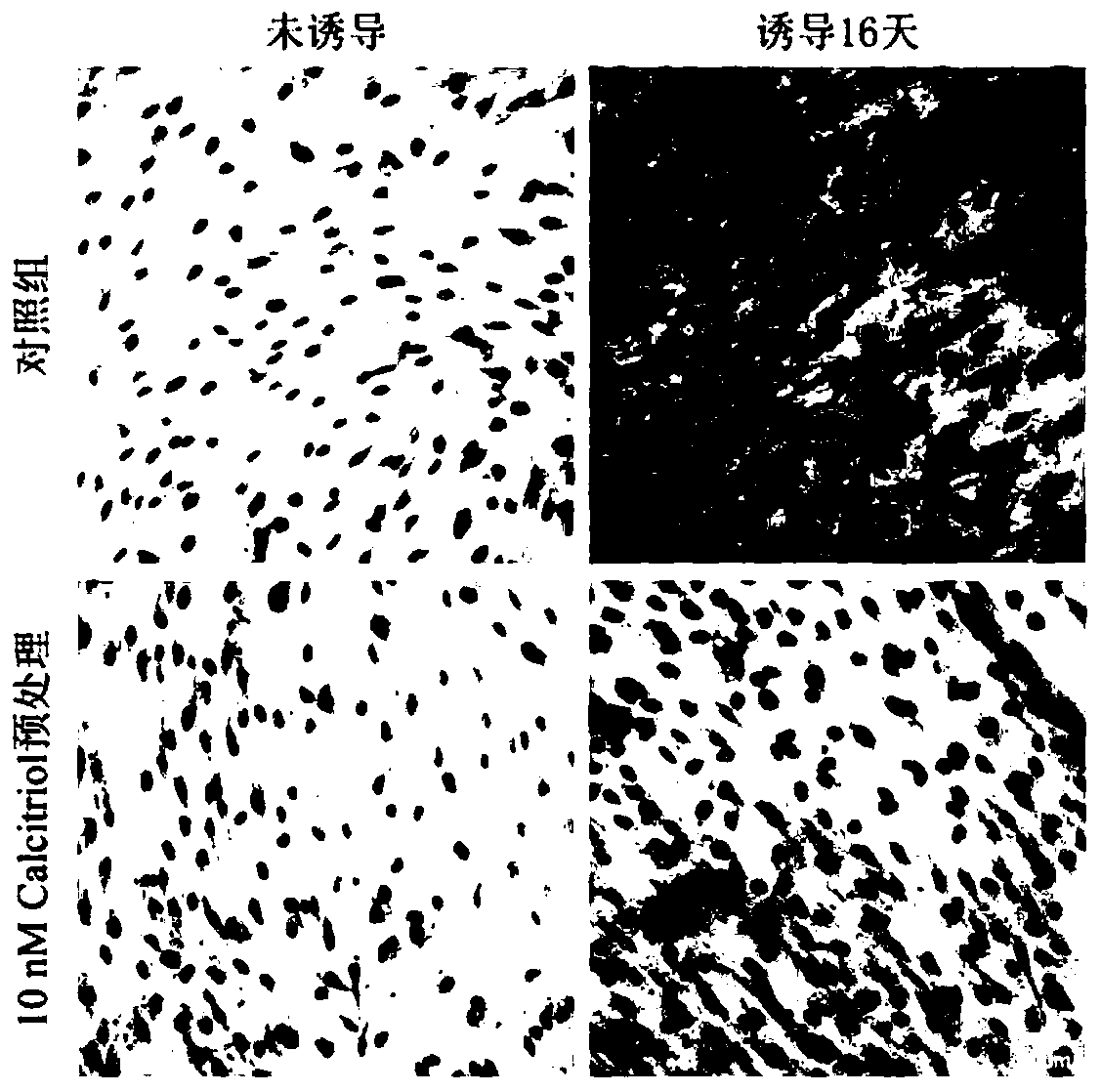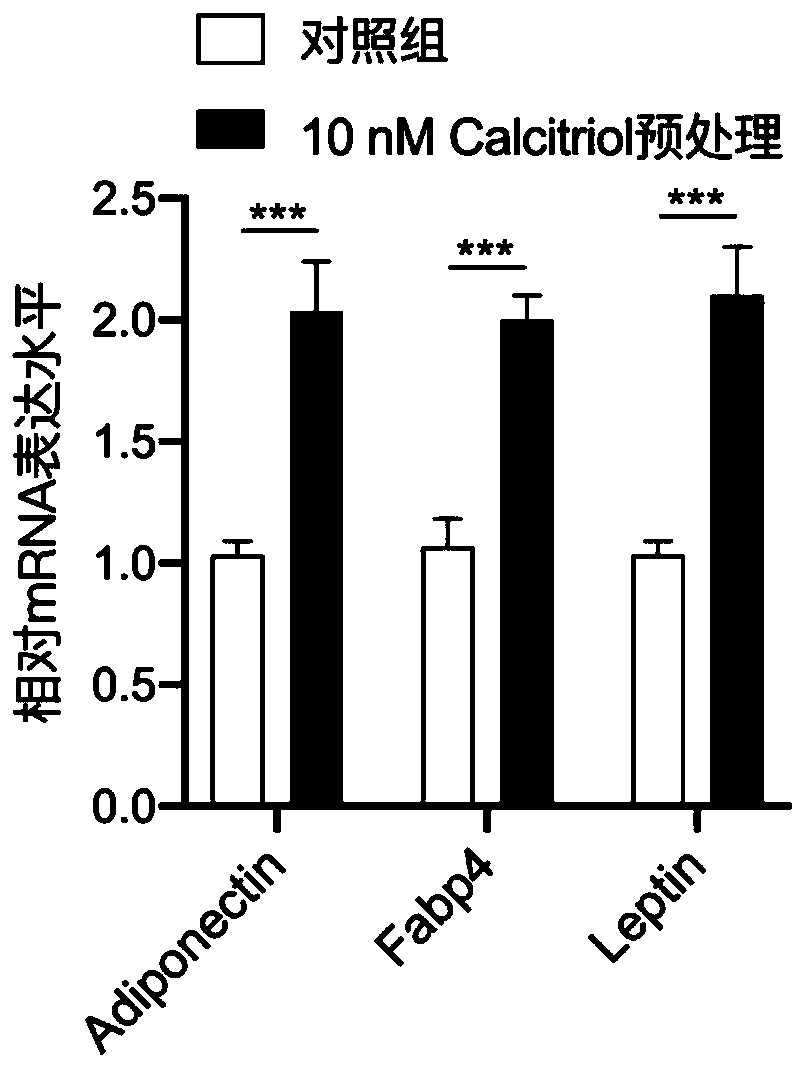Application of vitamin D3 and analogues thereof in promoting differentiation of human skin fibroblasts into adipocytes
A fibroblast and adipocyte technology, applied in the biological field, can solve the problems of difficult wound repair, scar repair lipodystrophy treatment, low efficiency of skin fibroblast differentiation into adipocytes, etc., and achieve efficient induction of differentiation into , the effect of improving efficiency
- Summary
- Abstract
- Description
- Claims
- Application Information
AI Technical Summary
Problems solved by technology
Method used
Image
Examples
Embodiment 1
[0081] Embodiment 1 Efficient in vitro method for inducing human skin fibroblasts to differentiate into adipocytes
[0082] In this example, 24-hour pretreatment with 10 nM vitamin D3 (Calcitriol) was taken as an example to illustrate the results of differentiation induction.
[0083] The method of inducing differentiation is as follows:
[0084] 1. Passage the isolated primary HDF cells to a 35mm culture dish covered with a cover glass, add 3ml of basal medium, and place in a place containing 5% CO 2 in a cell culture incubator at 37°C;
[0085] 2. After the cell confluency reaches 50-70%, add vitamin D3 with a final concentration of 10nM, and pretreat the cells for 24 hours;
[0086] 3. Suck off the basal medium, add the induction differentiation medium ①, and continue the induction culture for 6 days, and replace the fresh medium every two days;
[0087] 4. Suck off the differentiation induction medium ①, add the differentiation induction medium ②, and induce culture for...
Embodiment 2
[0096] Example 2 Efficiently Inducing Human Skin Fibroblasts to Differentiate into Adipocytes in Vitro
[0097] In this example, 50 nM vitamin D3 (Calcitriol) was pretreated for 24 hours as an example to illustrate the results of differentiation induction.
[0098] The method of inducing differentiation is the same as in Example 1, and the "6+2+8" mode of inducing differentiation is also adopted. The difference is that the pretreatment was changed to 50 nM vitamin D3 pretreatment for 24 hours.
[0099] After the end of the induced differentiation, the results of the induced differentiation were detected by oil red staining and detection of mature adipocyte marker genes. The result is as follows:
[0100] ①Oil red staining results
[0101] Such as Figure 4 As shown, the red part is the stained fat, and the uninduced HDF cells have no fat accumulation, while the HDF cells induced to differentiate for 16 days have obvious fat accumulation. And compared with the control grou...
Embodiment 3
[0106] Example 3 Efficiently Inducing Human Skin Fibroblasts to Differentiate into Adipocytes in Vitro
[0107] In this example, 10 nM calcipotriol (Calcipotriol) was pretreated for 24 hours as an example to illustrate the results of differentiation induction.
[0108] The method of inducing differentiation is the same as in Example 1, and the "6+2+8" mode of inducing differentiation is also adopted. The difference is that the pretreatment was changed to 10 nM calcipotriol pretreatment for 24 hours.
[0109] After the end of the induced differentiation, the results of the induced differentiation were detected by oil red staining and detection of mature adipocyte marker genes. The result is as follows:
[0110] ①Oil red staining results
[0111] Such as Figure 7 As shown, the red part is the stained fat, and the uninduced HDF cells have no fat accumulation, while the HDF cells induced to differentiate for 16 days have obvious fat accumulation. And compared to the control ...
PUM
 Login to View More
Login to View More Abstract
Description
Claims
Application Information
 Login to View More
Login to View More - R&D
- Intellectual Property
- Life Sciences
- Materials
- Tech Scout
- Unparalleled Data Quality
- Higher Quality Content
- 60% Fewer Hallucinations
Browse by: Latest US Patents, China's latest patents, Technical Efficacy Thesaurus, Application Domain, Technology Topic, Popular Technical Reports.
© 2025 PatSnap. All rights reserved.Legal|Privacy policy|Modern Slavery Act Transparency Statement|Sitemap|About US| Contact US: help@patsnap.com



